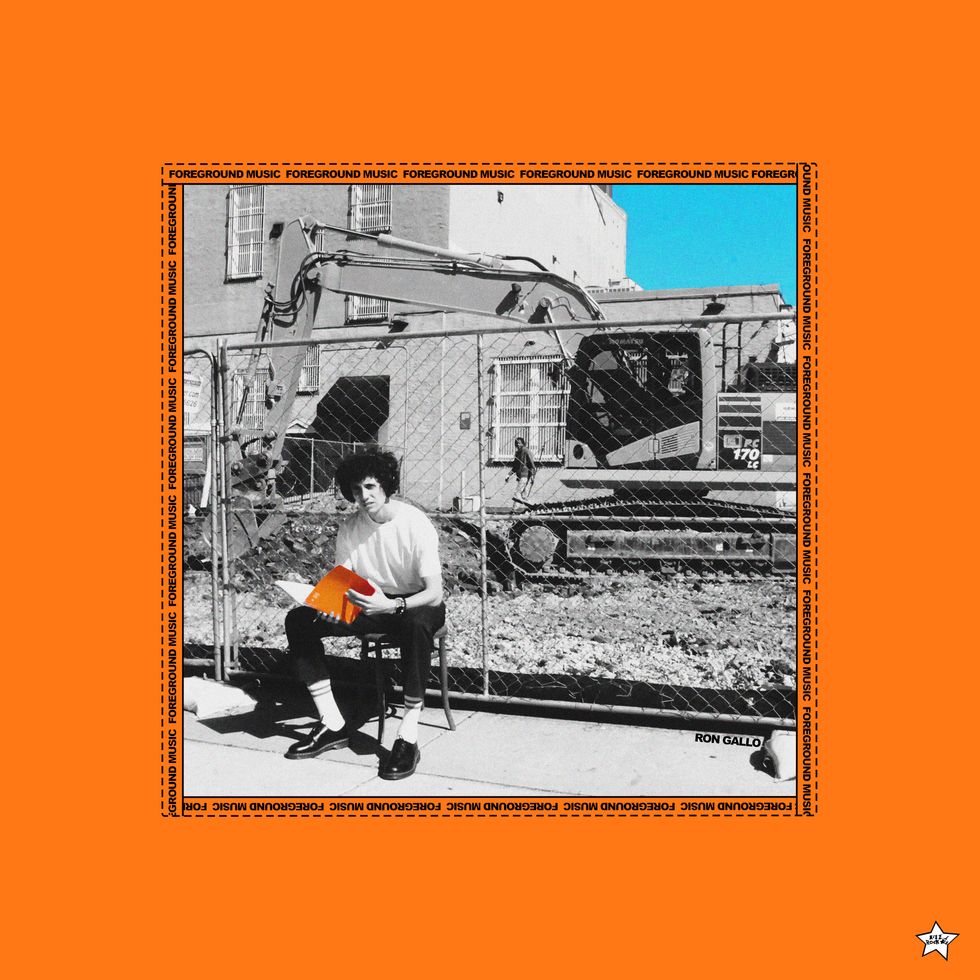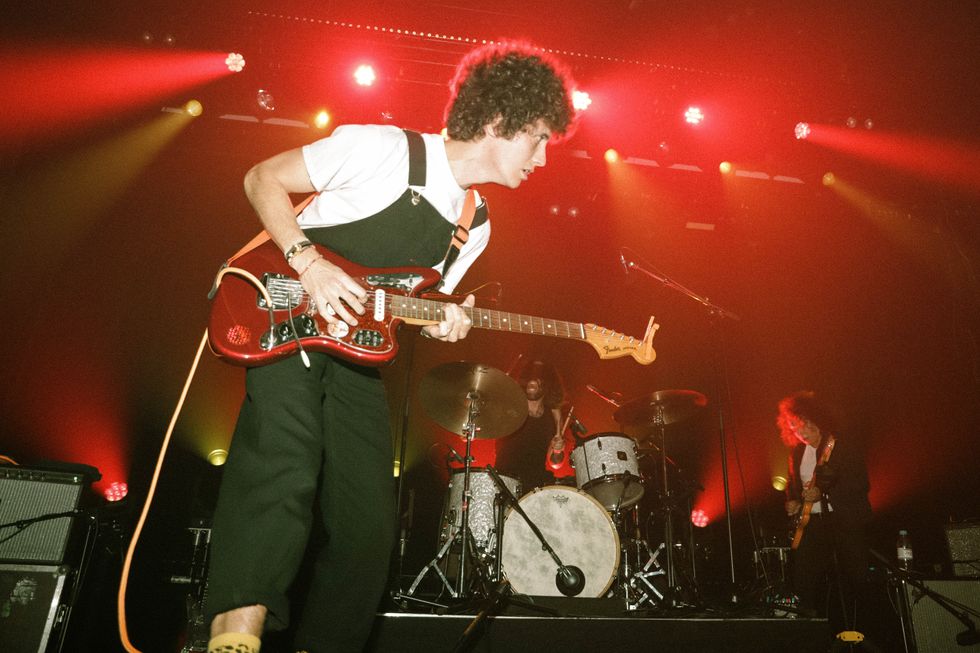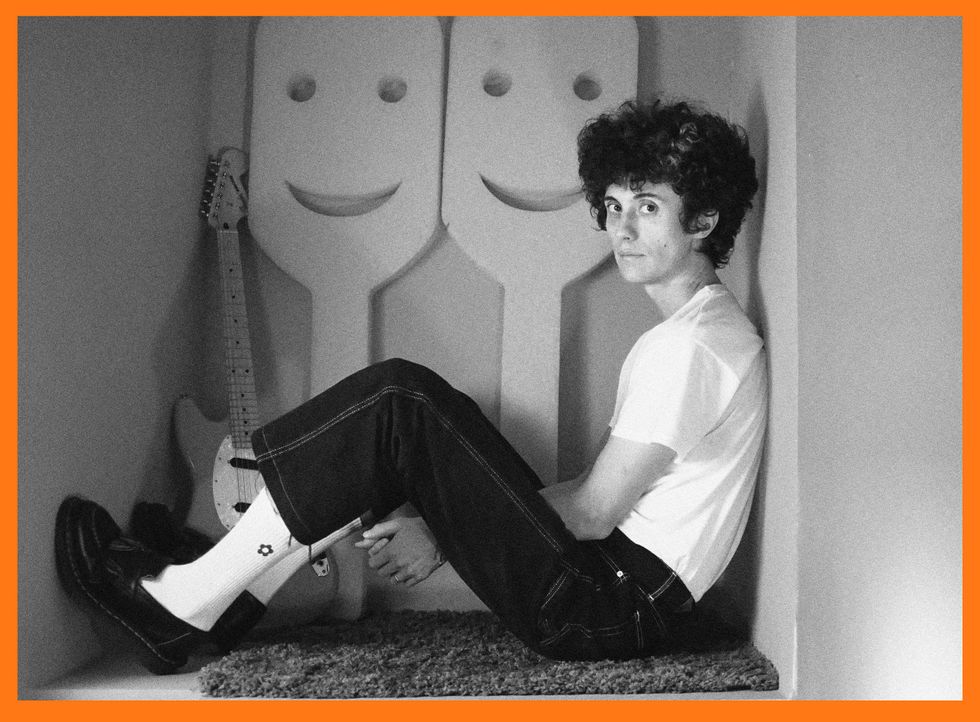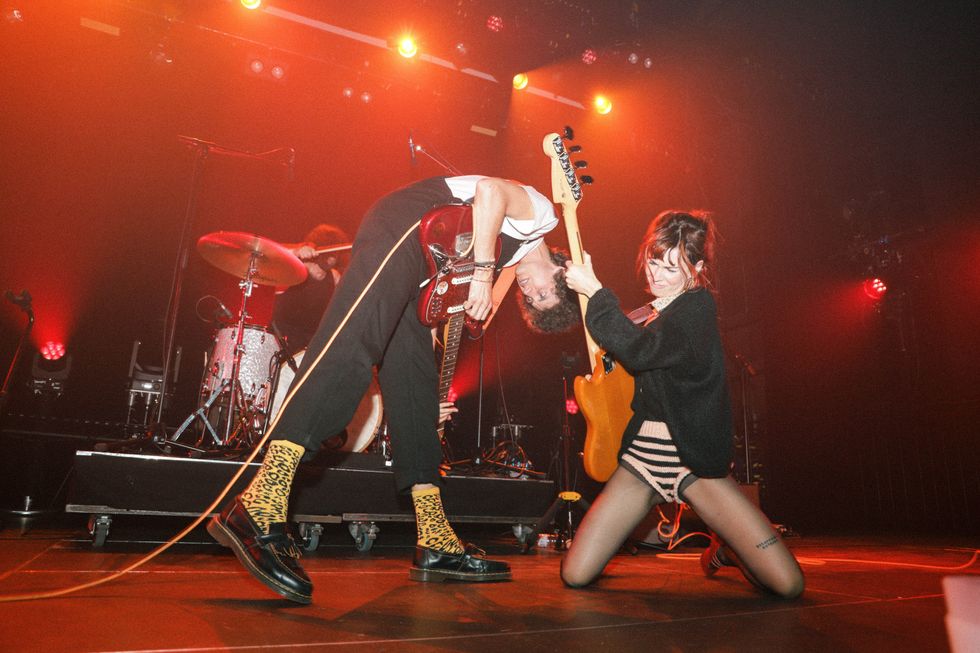Ron Gallo has a quick answer when asked what went into his latest record, the cheekily titled full-length FOREGROUND MUSIC. “Pure, daily, existential crisis,” the Philadelphia-based musician says in a flat, sarcastic tone.
He’s joking, but only a little. Gallo says the early days of the pandemic removed the usual distractions from his day-to-day life, and he was left to engage with and reflect on the world around him, uninterrupted. It started to feel like he was stuck between two extremes.
“If you’re tuned into news and social media and paying attention to everything that’s happening everywhere, the world can seem absolutely chaotic,” says Gallo. “But then you can walk out your front door and you’re like, ‘Oh, it’s a nice day, the neighbors are nice, and I’m okay.’ It’s like living in two realities simultaneously.”
FOREGROUND MUSIC is in part an effort to make sense of how to navigate between those two states. There are moments of relief and calm, but the record is most often tense and sharp—a tightly coiled spring threatening to burst. Gallo’s lyrics are acidic and blunt. The spoken-word interlude on the title track sounds like someone yanked open the cranium of a chronic overthinker and funneled their brain’s stream-of-consciousness anxieties right onto a page: “By the way, how are there so many t-shirts on Earth? / I mean, let's say on average everyone has 15 / You times that by billions of people / How is there enough raw materials?”
Ron Gallo - "SAN BENEDETTO"
It’s not just anxiety for anxiety’s sake. Releasing the pressure from a vessel allows it to function at full potential. “When you’re overwhelmed by the dread of everything that’s happening, it can feel really intense,” says Gallo. “But it’s mobilizing at the same time.”
FOREGROUND MUSIC is the fifth studio LP in his discography (which started with his 2014 debut RONNY), and his first on legendary Oregon independent label Kill Rock Stars. It started coming together on a day off of touring in upstate New York in October 2021, when the band stayed at a friend’s studio and demoed new tracks. They then took them back to Philadelphia, where they re-recorded them at home and live off the floor at drummer Josh Friedman’s studio. It was the first time that Gallo, along with bassist Chiara D’Anzieri and guitarist Jerry Bernhardt, decided to invest in home recording gear and learn how to use it, including a Universal Audio Apollo interface. The guitars on the album were recorded either with an SM57 on a Fender Princeton into Gallo’s DAW, or straight-up direct input into the Apollo.
“I’ve always relied on other people for what I considered passable recording. I just never trusted myself to do it,” says Gallo. “It was kind of learning it ‘as we go.’” The experience was liberating. On 2021’s PEACEMEAL, Gallo’s former label, New West Records, insisted he work with a well-known producer in an expensive, well-appointed studio. This time, he went back to his DIY roots—and it paid off. “You don’t have to spend all this money and go to these big fancy studios to get good sounds,” says Gallo. “[Doing it yourself] feels like beating the system.”

The music on Gallo’s latest release has elements that range from stream-of-consciousness lyrics to garage-y fuzz to surreal ’80s strumming to rockabilly punch.
Gallo’s rig, too, is free of bells and whistles. While he got a Fender Mustang in late 2021 to bring on tour, an olive-green Jaguar that he bought off “a kid on Facebook Marketplace” in Philadelphia seven years ago has been his go-to. (Though he recently added a second Jag, in sharp orange to match the record’s aesthetic.) “As shallow as it is, I’m usually drawn to the look of things,” he says. “Even if they’re shitty, I usually play pretty primally anyway.” The aforementioned Princeton—paired with a Tube Screamer, a ZVEX Fat Fuzz Factory, and a Boss delay—has backed Gallo for just as long.
“I’m not a tone guru, where I’m really precious about my sound,” he says. “It’s like trying to arrive at tonal mecca. It could be endless. I just would rather not even start that path, really. As long as it works, it’s good for me.”
This might come as a surprise for fans of FOREGROUND MUSIC. The record is packed with thick, rich guitar tones, ranging from garage-y fuzz to swampy blues chording to abandoned-building reverb swells on lazy barre chords. There is the dirt-smeared, barking riff of opener “ENTITLED MAN”; the glitchy, blown-speaker solo on “SAN BENEDETTO,” which finds Gallo lamenting the inhumanity of American versus Italian lifestyles; the surreal, watery ’80s strumming of “YUCCA VALLEY MARSHALLS”; and the clean-and-clear rockabilly punch of “VANITY MARCH.”Ron Gallo's Gear

For FOREGROUND MUSIC, Gallo, drummer Jerry Bernhardt, and bassist Chiara D’Anzieri—pictured here—invested in home recording gear for the first time, to produce the album without the frills of a fancy studio.
Photo by Loelia Photography
Guitars
- Fender Jaguar
Amps
- Fender Princeton
Effects
- Ibanez TS9 Tube Screamer
- ZVEX Fat Fuzz Factory
- Boss DD-2 Digital Delay
Strings & Picks
- Ernie Ball Custom Flatwound Strings (.011s)
- Dunlop .73 mm grip picks
The versatility and breadth of voice with simple equipment is a product of Gallo’s musical upbringing. He came up playing chaotic shows in basements and DIY spaces without monitors, let alone sound engineers, so he learned quickly how to sound alright on a dime. “I’ve always been of the mindset to be able to pull it off in any scenario or as simply as possible,” says Gallo. “It was just kind of out of necessity, and that’s just always stuck with me.”
Even Gallo’s relationship with the guitar itself started as a means to an end rather than a primary passion. “It was more just a vehicle for making songs, really,” he says. “It seemed like the easiest way to make stuff. I’ve always viewed it that way.”
Gallo arrived at the phrase “foreground music” years ago when someone asked what kind of music he played. It feels at least like a clever retort to increasingly algorithmic playlist-ification, a process that has transformed music from a distinct artistic work to an abstract mood-enhancing service. “Foreground music” became Gallo’s default answer in response to the question of what genre he produced, because it suggested a simple idea: Gallo’s work is meant to be engaged with, not flicked on as ambience for another activity. “It’s something you face and deal with, and maybe derive some kind of frustration or anxiety or intensity from,” says Gallo. “It kind of fit the record, too.”
Much of FOREGROUND MUSIC’s ire is driven by the foreclosure of organic, human experiences in a mad dash for profits. Over the short, abrasive noise-spiral of “LIFE IS A PRIVILEGE? (INTERLUDE),” Gallo delivers a delayed response to a listener from a place (ostensibly his native Philadelphia, to which he returned from Nashville in 2019) “where it costs twice as much to live, but life is not getting any better.” His tirade climaxes near the end: “You get buried, and they’ll put condos on top of it / Ya, you get buried, and they’ll profit off of it / You get buried, life is a privilege.”

Part of Gallo’s artistic inspiration comes from his frustration with expensive housing developments that create “chaos and disruption” in long-established communities and neighborhoods.
Photo by Chiara D’Anzieri
Gallo and the band used the record to physically push back against these things. In May 2022—a little less than a year before its official release—the band appeared unannounced on a rooftop in Philadelphia’s Fishtown neighborhood to perform FOREGROUND MUSIC in its entirety while a camera crew captured the show. Curious onlookers stopped and watched. Some even sat down to take in the music. The film was released on YouTube, titled “BEFORE THE BUILDING GOES: FOREGROUND MUSIC LIVE & UNANNOUNCED.”
It all took place on the edge of a broad, empty swath of rubble and dirt right next to Gallo’s house. It’s slated to become a condo building, leaving Gallo’s street looking like “a warzone.”
“At the end of the day, there’s gonna be these big, clean, new, fresh buildings, but the process to get there is total destruction and chaos and disruption,” says Gallo. The condos will also steamroll a beloved neighborhood mural. “Of course some idiot is gonna build some dumb for-profit, $5000-a-month shoebox apartments in there, getting no permission [from current residents],” groans Gallo.
Gallo sighs that the people behind the development likely don’t live anywhere near the site, and therefore “don’t give a shit about who it’s impacting.” “That mindset seems to be driving all of the really backwards shit that is happening all over,” he says. The rooftop show last year was a manner in which Gallo could hit back in his own way. “It was a bit of a memorial to before and after,” he says.

When the band was faced with a sudden, literally last-minute cancellation of a festival gig in Spain back in April, Gallo says, “It put us all in a state of surrender. You just have to find a way to laugh at it.”
Photo by Chiara D’Anzieri
In late April, Gallo and his band flew to Portugal to catch a connecting flight to Spain, where they were slated to play Warm Up, an outdoor festival in Murcia. They had set up their gear and were 10 minutes out from their set time when a violent, windy rainstorm swamped the festival grounds. It felt ludicrous, unthinkable: After the better part of two years off the road during the pandemic and a transatlantic trip to play a coveted festival, with a vital new record to share, a chaotic weather event smashed their best-laid plans.
By the time the group were in the van on their way to a gig in Cologne, Germany a few days later, the stress of the tumult had started to fade into black, fatalist comedy. “It put us all in a state of surrender,” says Gallo. “You just have to find a way to laugh at it.”Even with the hitches, taking FOREGROUND MUSIC on the road has been cathartic. People who attend his shows have told Gallo how closely his struggles on the record resemble their own. It’s a double-edged comfort: It proves that these problems exist all over the place, but it also demonstrates that there are others—thousands of others—who want to change the way things are. That, for Gallo, is the whole point. “When I went to make FOREGROUND MUSIC, I kind of asked myself, ‘What even justifies making an album right now?’” he says. “The [point] was, well, to talk about what most people are experiencing.”
Ron Gallo - I LOVE SOMEONE BURIED DEEP INSIDE OF YOU (Live at Tournament Studios)
Channeling classic songwriting greats like Bob Dylan and Leonard Cohen, Ron Gallo croons “I love someone buried deep inside of you” over meditative, fuzzified chords and a clean and simple rhythm section.






![Rig Rundown: Russian Circles’ Mike Sullivan [2025]](https://www.premierguitar.com/media-library/youtube.jpg?id=62303631&width=1245&height=700&quality=70&coordinates=0%2C0%2C0%2C0)
































![Rig Rundown: AFI [2025]](https://www.premierguitar.com/media-library/youtube.jpg?id=62064741&width=1245&height=700&quality=70&coordinates=0%2C0%2C0%2C0)











